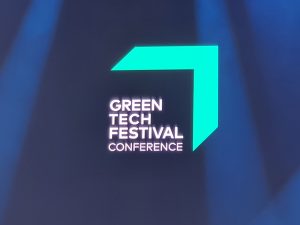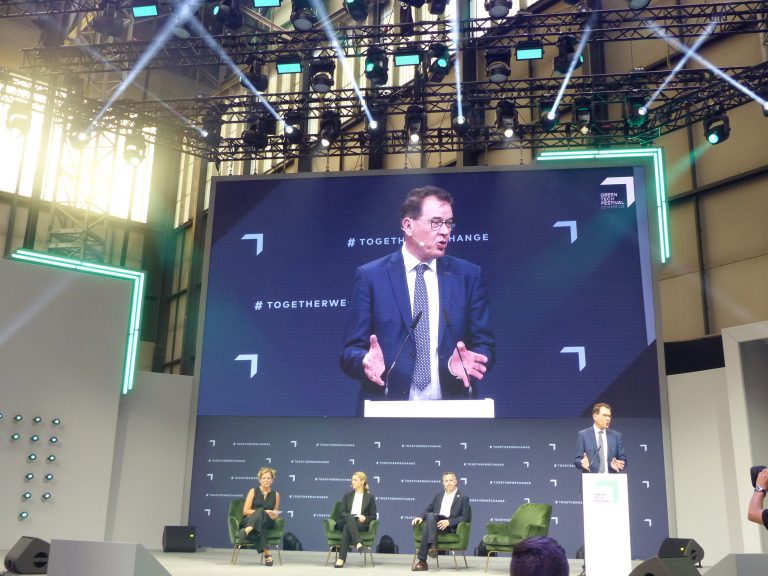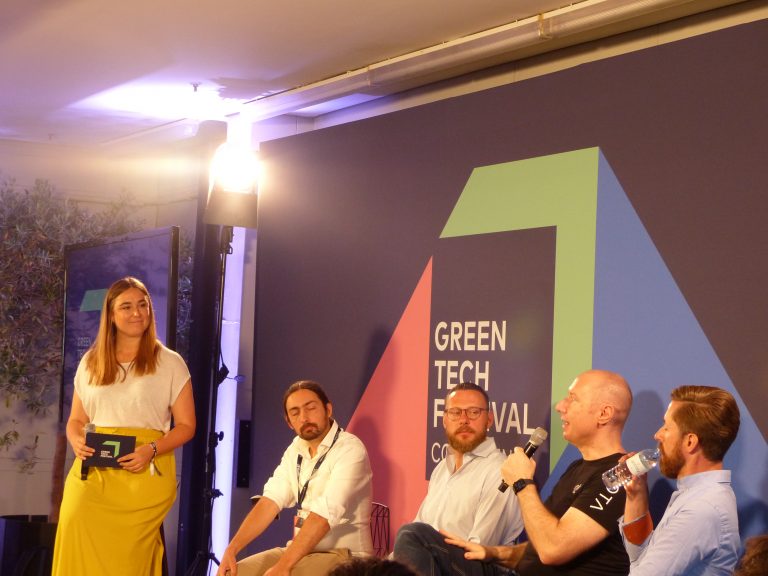From June 22 to 24, the Green Tech Festival took place on the former airport grounds in Berlin Tegel – in a hangar and on the airfield. Since future-oriented technology goes directly hand in hand with digitalization, I was curious to see what would be discussed and presented.
 The event was divided into two major sections: Conference and Exhibition, which to my understanding also had different target groups. The conference and the exhibition in the hangar were clearly business-oriented, where international companies presented their sustainable solutions and strategies, which they also put up for discussion during the conference. The exhibition on the airfield was more consumer-oriented, where regional companies and startups presented their sustainable products and ideas.
The event was divided into two major sections: Conference and Exhibition, which to my understanding also had different target groups. The conference and the exhibition in the hangar were clearly business-oriented, where international companies presented their sustainable solutions and strategies, which they also put up for discussion during the conference. The exhibition on the airfield was more consumer-oriented, where regional companies and startups presented their sustainable products and ideas.
The Green Tech Festival is an international, even global event. It was opened by representatives of the UN, among others. Gerd Müller, Director General of the UN Industrial Development Organization (UNIDO), impressively drew attention to the problems of this planet and its future prospects in his keynote speech. The rapid climate change caused by us humans demands on the one hand that we reduce or stop its causes, but also strategies for the use of the remaining resources such as agriculturally usable soil. Not only the war in Ukraine shows that the supply of food is a global task. The UN expects humanity to comprise about 10 billion individuals in 2050. These people want to be fed, they want to work, they want to live, they want to be educated. There are clear strategies and solution scenarios for how all this can be implemented. Mr. Müller’s call was very clear that this has to be done now. Left unsaid were the questions of why this is not yet being addressed consistently, and what will happen if we don’t change. The answers are too obvious.

Gerd Müller, Director General of the UN Industrial Development Organization (UNIDO), is opening the Conference.
This opened the scope of the conference, it was about real, sustainable solutions. Projects and products around mobility, food, energy efficiency, smart city, digital infrastructure, recycling, … were presented. In the exhibition outside there were also topics like sustainable living, how to deal with textiles, natural materials, recycling, cosmetics, …
For me, the most interesting session was the Deepdive “Green Clouds, Blockchain and ICT”. Last year, internet infrastructure emitted more CO2 than the airline industry, and Bitcoin alone has a larger C02 footprint than New Zealand. While many IT and communications providers are doing their part to become more sustainable, in many cases a rethink is needed regarding how we engage and consume digital technology.
First, this panel clarified that there is a difference between Green IT and Sustainable IT. Green IT basically means that, for example, the energy consumed consists of solar or wind power and that the data centers reuse their waste heat, that they operate in a CO2-neutral manner. This is an important component of sustainability. But sustainability also includes responsibility for what IT is used for. Sustainability involves the entire ecosystem. How sustainable is a climate-neutral data center, for example, if it contains the infrastructure and data processing of a fracking company?
Furthermore, the illusion of sustainable technology was disenchanted. Technology is fundamentally open to use, it can be used sustainably or unsustainably. One can hardly say that this or that technology is sustainable per se. Technology is a tool that can only be as sustainable as what is done with it.
It became clear that there must be measurement options and transparency; only when all real data is available and there is knowledge about the possibilities of saving energy, for example, can an infrastructure be (re)designed to be energy-efficient and CO2-neutral. But only when responsibility for the processes and the sustainability of what is produced with the IT is added, can one speak of sustainable IT.

Panelists of “Green Clouds, Blockchain and ICT”.
As was the case throughout the conference, this panel was strongly critical of green-washing and that covering up emissions by buying allowances is the wrong way to go about it. That only postpones the problem into the future. And it is precisely in the future that the problems are supposed to be solved… The possibilities that already exist to reduce energy consumption and, for example, to use waste heat sensibly must be implemented. Even if these are initially small steps, they are active steps in the right direction.
I had a bit of an a light bulb moment when Chris Adams from the Green Web Foundation and the Green Software Foundation spoke, the goal is to make the internet fossil free by 2030. To achieve that, all the facts need to be on the table now. And since we’re talking about the global Internet, that’s quite a lot of facts. I’m already looking forward to the interview with Chris, where he’ll talk more about the goals, but also what’s already been achieved.
A final takeaway from the conference: we can all only achieve a sustainable, long-term future together! What if it works? (Verena Pausder, founder of Digitale Bildung für Alle e.V., on the KOA stage).
https://www.thegreenwebfoundation.org
https://greensoftware.foundation/
https://digitalebildungfueralle.org/
Friederike Zelke
